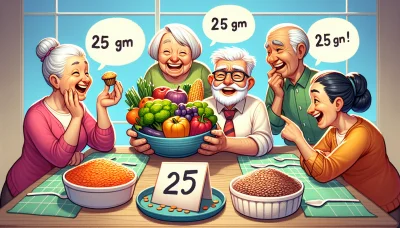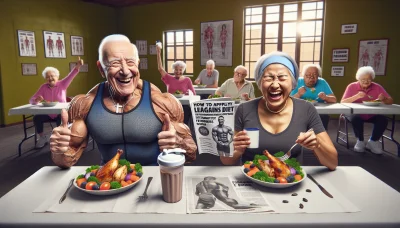Foods with high fiber and low carbs Quiz
Test Your Knowledge
Question of
Understanding High Fiber, Low Carb Foods
The Role of Fiber in Your Diet
Fiber is a pivotal component of a healthy diet, acting as the broom that sweeps your digestive system clean. Unlike other food components such as fats, proteins, or carbohydrates which your body breaks down and absorbs fiber isn't digested by your body. Instead, it passes relatively intact through your stomach, small intestine, and colon and out of your body.
It's this passage through your intestines that lends fiber its remarkable health-promoting properties. By adding bulk to your diet, fiber helps you feel full faster and longer, making it a dieter's best friend. Moreover, it aids in digestion and can help prevent constipation by keeping bowel movements regular.
Health Benefits of Dietary Fiber
Dietary fiber is like a nutritional superstar it's linked to a lower risk of developing various conditions, including heart disease, diabetes, digestive disorders, and more. Soluble fiber found in oats, peas, beans, and many fruits dissolves in water to form a gel-like substance that can help lower blood cholesterol and glucose levels.
Insoluble fiber found in whole grains, wheat bran, and vegetables adds bulk to the stool and appears to help food pass more quickly through the stomach and intestines. This action keeps you feeling lighter and may also aid in the prevention of colorectal cancer.
Recommended Daily Fiber Intake
The recommended daily intake for fiber varies with age and gender; however, general guidelines suggest that women should aim for about 21 to 25 grams per day while men should target 30 to 38 grams. Most people are falling short only about 5% of Americans meet these recommendations!
To boost your fiber intake, focus on whole fruits over juices, replace white rice with quinoa or brown rice and choose whole-grain bread instead of white bread. Remember: ramp up your intake gradually and drink plenty of water to avoid any discomfort.
Identifying Low Carb Foods
Low carb foods are integral to numerous dietary strategies aimed at improving health and managing weight. Foods naturally low in carbohydrates include lean meats, fish, eggs, leafy green vegetables, nuts and seeds. These foods also tend to be high in other nutrients like protein or healthy fats.
Paying attention to carbohydrate content is crucial for people following a ketogenic diet or those with diabetes who need to manage their blood sugar levels meticulously. Low carb diets have been shown to promote weight loss and improve heart health markers in some individuals.
The Importance of Low Carb for Weight Management
Low carb diets have taken center stage in weight loss discussions. By limiting carbohydrates especially refined carbs like sugar the body must turn to stored fat for energy which can lead to weight loss. Additionally, low carb diets often result in reduced appetite because they stabilize blood sugar levels which can prevent overeating.
Beyond weight management, reducing carb intake may also benefit metabolic health by improving insulin sensitivity. People with insulin resistance or type 2 diabetes often see significant benefits from adopting a lower carb intake as part of their dietary strategy.
How to Read Nutrition Labels for Carb Content
Nutrition labels are your roadmap to understanding the carb content of packaged foods. The total carbohydrate count includes sugars, complex carbs, and dietary fiber - but remember that fiber doesn't raise blood sugar levels like other carbs do since it's not absorbed.
- *
- Total Carbohydrates: Start here for the big picture on how much carbohydrate is in a serving. *
- Dietary Fiber: Subtract this from total carbs if you're counting net carbs since it has minimal impact on blood sugar. *
- Sugars: Look at both natural sugars (like lactose in milk) and added sugars which are important to minimize for overall health. *
- Serving Size: All the information on the label refers to one serving size make sure you adjust if you eat more or less than what's described.
Balancing Fiber and Carbs in Meals
Balancing high fiber with low carb intake requires strategic meal planning but it's absolutely doable! Aim for variety by including lots of non-starchy vegetables alongside smaller portions of complex carbs like sweet potatoes or legumes which provide both nutrients without going overboard on carbs.
Planning a Balanced Meal
To plan a balanced meal that's both rich in fiber and low in carbs start with filling half your plate with non-starchy vegetables such as spinach broccoli cauliflower or bell peppers Then add a good protein source like chicken fish tofu or beans Finally round out the meal with a small portion of complex carbohydrates such as quinoa barley or wild rice
Sample High Fiber Low Carb Recipes
If you're looking for inspiration check out recipes like zucchini noodles topped with avocado pesto grilled salmon with roasted Brussels sprouts or kale salad packed with nuts seeds And don't forget breakfast! A chia seed pudding made with almond milk can kickstart your day with both high fiber content AND low carb excellence!
Top High Fiber, Low Carb Foods to Include in Your Diet
Vegetables High in Fiber and Low in Carbs
Integrating high-fiber, low-carb vegetables into your diet is a game-changer! These nutrient powerhouses support digestive health and can help maintain blood sugar levels. They're versatile in recipes, from salads to stir-fries, ensuring your meals are not only healthy but also delicious.
When it comes to shopping for these veggies, focus on variety and freshness. The fresher the produce, the higher the nutrient content. Farmers' markets and organic sections in grocery stores are ideal spots to find quality vegetables that fit into a low-carb lifestyle.
Leafy Greens and Their Nutritional Profile
Leafy greens like spinach, kale, and Swiss chard are nutritional titans loaded with fiber yet low in carbohydrates. These greens contain essential vitamins such as K, A, and C, making them an integral part of a balanced diet. Their versatility means you can enjoy them raw or cooked without losing their nutrient value.
Incorporating leafy greens into daily meals is effortless. Add them to smoothies for a nutritional punch or saut them as a side dish. Remember that cooking methods matter; steaming or sauting preserves nutrients better than boiling.
Cruciferous Vegetables as a Fiber Source
Cruciferous vegetables like broccoli, cauliflower, and Brussels sprouts are fiber-rich champions. They offer a satisfying crunch and are packed with phytonutrients that may reduce inflammation. Their low carb profile makes them perfect for anyone monitoring their carbohydrate intake.
Eating these vegetables regularly contributes to your overall fiber intake significantly. They're easy to prepare roast them with a drizzle of olive oil or incorporate them into casseroles for a hearty meal that's both nutritious and fulfilling.
Nutrient-Dense Fruits with Low Carb Counts
Fruits can be part of a high-fiber, low-carb diet when chosen wisely. Focusing on fruits with lower sugar content ensures you get essential nutrients without the carb overload. These fruits can satisfy sweet cravings while aligning with dietary goals.
Berries and Their Health Benefits
Berries such as strawberries, raspberries, and blackberries offer an abundance of health benefits while being low in carbs. They're rich in antioxidants which combat oxidative stress and may protect against chronic diseases. Berries add natural sweetness to any meal or snack without spiking your blood sugar levels.
- Raspberries: Offer one of the highest fiber contents among fruits while keeping carbs minimal.
- Blueberries: Known for their antioxidant properties and brain health benefits.
- Strawberries: Provide vitamin C along with fiber, making them great for skin health and immunity.
Avocado: A Unique Fruit with Healthy Fats and Fiber
The avocado stands out as a unique fruit predominantly rich in healthy fats but also provides fiber. Its creamy texture makes it suitable for various dishes from savory to sweet. Avocados contribute to heart health due to their monounsaturated fat content.
This versatile fruit can be incorporated into diets effortlessly spread it on toast, add it to salads, or blend it into smoothies. Not only does it offer richness to dishes but also significantly ups the fiber content of your meals.
Seeds and Nuts for Satiety and Nutrition
Nuts and seeds are the ultimate high-fiber, low-carb snacks that promote satiety while providing an array of nutrients. These tiny but mighty foods pack a punch with protein, healthy fats, vitamins, and minerals that support overall well-being.
Chia Seeds and Flaxseeds for Omega-3s and Fiber
Chia seeds and flaxseeds are exceptional sources of omega-3 fatty acids which promote heart health. They're also incredibly high in fiber which aids digestion. Adding these seeds to your diet is straightforward sprinkle them over yogurt or blend into smoothies for added texture and nutrition.
Almonds and Walnuts for Protein and Healthy Fats
Almonds are not just crunchy treats; they're nutritionally dense offering protein, healthy fats, vitamin E, magnesium among other nutrients - all while being low in carbs! Similarly, walnuts provide valuable plant-based omega-3 fatty acids essential for brain health.
Integrating High Fiber, Low Carb Foods into Popular Diets
Keto Diet: Staying in Ketosis with Fiber-Rich Foods
Understanding Net Carbs
The keto diet revolves around maintaining a state of ketosis by limiting carbohydrate intake. It's crucial to understand the concept of net carbs, which is the total carbs minus fiber content. This calculation helps keto followers eat the right foods without disrupting ketosis.
Fiber is essential as it doesn't spike blood sugar levels, allowing for a more consistent energy supply and better digestive health. Therefore, selecting high-fiber foods that have low net carbs is key to a successful keto diet.
Keto-Friendly High Fiber Foods
Avocados, flaxseeds, and chia seeds are among the top high-fiber, low-carb foods suitable for a keto lifestyle. These foods help maintain gut health while keeping carb counts in check. Berries like raspberries and blackberries can also be included in small portions for their fiber content.
Nuts and green leafy vegetables are your allies on keto; they pack a powerful fiber punch with minimal carbs. Incorporating these into your diet enhances nutritional intake without compromising ketosis.
Paleo Diet: Emphasizing Whole, Unprocessed Foods
The Paleo Approach to Carbs and Fiber
The paleo diet encourages the consumption of whole, unprocessed foods that were presumably eaten by our Paleolithic ancestors. This means focusing on vegetables, fruits, nuts, and seeds for fiber intake while minimizing processed carbs.
Understanding that not all carbs are created equal is crucial for those following a paleo diet. Complex carbohydrates found in whole foods are often high in fiber and nutrients compared to refined carbs.
Paleo-Compatible High Fiber Options
- Vegetables like broccoli and Brussels sprouts are nutrient-dense and fit perfectly within the paleo framework.
- Fruits such as apples and pears should be consumed with their skin on to maximize fiber intake.
- Nuts and seeds are excellent snacking options providing both healthy fats and fiber.
- Root vegetables like sweet potatoes offer a good source of fibrous carbs suitable for paleo dieters.
Vegan Diet: Plant-Based Sources of Fiber without the Carbs
Meeting Protein Needs on a Vegan Diet
While focusing on high-fiber, low-carb foods, vegans must also ensure they meet their protein requirements. Legumes such as lentils and chickpeas provide both protein and fiber but should be balanced with lower-carb plant foods to maintain dietary goals.
Tofu and tempeh are versatile protein-rich options that can easily be incorporated into a vegan diet without adding excessive carbohydrates.
Vegan Foods That Are Naturally Low in Carbs
Leafy greens such as spinach and kale offer substantial amounts of fiber while being naturally low in carbohydrates. These should form the base of many meals for those following a vegan low-carb diet.
Nuts, seeds, and certain berries can be enjoyed in moderation for their beneficial fats and fibers while keeping carb intake down. Zucchini noodles or cauliflower rice can replace traditional pasta or rice for satisfying meals with fewer carbs.
Meal Planning Strategies for High Fiber, Low Carb Diets
Creating a Weekly Meal Plan
Embarking on a high fiber, low carb diet begins with a solid meal plan. Start by identifying a variety of foods that fit your dietary goals, ensuring you have a mix of proteins, fats, and high-fiber carbohydrates. A diverse selection prevents boredom and increases adherence to your diet. Remember, planning is the key to success!
Once your food list is ready, sketch out meals for the week. Aim for balance in each mealcombine leafy greens with lean proteins and healthy fats. This approach not only simplifies grocery shopping but also streamlines cooking processes. A weekly meal plan serves as your roadmap to nutritional excellence.
Structuring Your Shopping List
A structured shopping list aligns with your meal plan and ensures you buy only what you need. Organize your list by food categories: produce, proteins, dairy, and pantry staples. Highlight high-fiber veggies and low carb items to stay focused while shopping. This method cuts down on impulse buys that could derail your diet.
Prioritize whole foods over processed items to maximize the health benefits of your high fiber, low carb diet. Look for fresh vegetables, nuts, seeds, and whole grains known for their fiber content. By sticking to the perimeter of the store where fresh foods are typically located, you'll naturally avoid higher-carb processed foods.
Prepping Meals in Advance
Meal prepping is a game-changer for maintaining dietary consistency throughout the week. Dedicate time to prepare bulk portions of staple dishes like grilled chicken or roasted vegetables. Divide these into individual servings for easy grab-and-go options during busy weekdays.
Incorporating variety through different spices and herbs can transform the same base ingredients into an array of exciting meals. Advanced preparation minimizes decision fatigue and helps you resist the temptation of off-diet choices when hunger strikes unexpectedly.
Portion Control and Macronutrient Balance
Understanding serving sizes is crucial in a high fiber, low carb diet. Familiarize yourself with standard portion sizes for different food groups using measuring cups or a kitchen scale at first. Eventually, you'll be able to eyeball portions accurately without extra tools.
If weight management is part of your goal, adjusting portions can help meet caloric needs without compromising on nutrition. Smaller portions can lead to weight loss while larger ones may support weight gain or maintenancetailor your plate accordingly!
Understanding Serving Sizes
Serving sizes on nutritional labels are not one-size-fits-allthey're merely guidelines. Evaluate them within the context of your daily caloric intake and macronutrient targets. Being mindful about serving sizes ensures you don't inadvertently overconsume carbs while seeking out fiber.
Becoming adept at reading labels helps identify hidden carbs in seemingly 'healthy' foods. Knowledge empowers you to make informed decisions about what goes on your plate and prevents common dietary mishaps.
Adjusting Portions for Weight Goals
Your individual weight goals play a vital role in determining portion sizes. For weight loss, focus on lean protein and fiber-rich vegetables that create fullness without excess calories. Conversely, those aiming for muscle gain might increase portions slightly while still favoring low carb options.
Maintain flexibility in your diet plan; if you find yourself hungry or unsatisfied after meals, it's okay to adjust portion sizes as needed while keeping carb counts in check.
Snacking on High Fiber, Low Carb Options
- Celery sticks with almond butter: A crunchy snack that combines healthy fats with satisfying fiber.
- Nuts and seeds: Packed with nutrients and easy to portion out for snacking.
- Berries: Offer natural sweetness along with fiber; perfect when paired with Greek yogurt.
- Hummus: Paired with cucumber or bell pepper slices makes an excellent midday treat.
- Cheese crisps: A savory alternative to chips that are low in carbs but high in flavor.
Avoiding Common Snacking Pitfalls
- Avoid mindless eating by portioning out snacks rather than eating from the bag.
- Stay clear of 'low-carb' processed snacks that may be high in unhealthy fats or artificial ingredients.
- Ditch sugary 'health' bars which often contain hidden carbs; read labels carefully!
Overcoming Challenges on a High Fiber, Low Carb Diet
Dealing with Digestive Changes
Transitioning to a high fiber, low carb diet can initially lead to digestive discomfort. Your body needs time to adapt to increased fiber, which is essential for gut health. Symptoms like bloating or gas are common but typically temporary as your digestive system adjusts.
Gradually Increasing Fiber Intake is key to minimizing discomfort. Start with small amounts of fiber-rich foods and increase your intake slowly over several weeks. This approach allows your digestive system to adapt without becoming overwhelmed.
When it comes to Staying Hydrated to Aid Digestion , water becomes your best ally. Adequate fluid intake helps soluble fiber do its job effectively, easing bowel movements and preventing constipation. Aim for at least eight glasses of water a day.
Finding Variety in Your Food Choices
A common misconception is that a high fiber, low carb diet limits food variety. However, an abundance of foods fit into this category, ensuring you can enjoy diverse and delicious meals every day.
Diving into Exploring International Cuisines for Inspiration can open up a world of flavors. Many cultures offer dishes that are naturally high in fiber and low in carbs, such as Mediterranean salads or Asian stir-fries with tofu and vegetables.
- Trying New Vegetables and Preparation Methods: Don't be afraid to experiment with vegetables you've never tried before or cooking them in new ways roasting, grilling, or spiralizing can transform them completely.
- Incorporate seeds like chia or flaxseed into your diet for an extra fiber boost.
- Create zucchini noodles or cauliflower rice as low-carb alternatives to traditional pasta and rice.
- Use lettuce wraps instead of bread for sandwiches and burgers.
- Add avocados to your meals for healthy fats and additional fiber.
Eating Out and Sticking to Your Diet Goals
Eating out doesn't have to derail your high fiber, low carb diet. With some planning and savvy decision-making, you can navigate restaurant menus while sticking to your goals.
When it comes to Making Smart Menu Choices , look for dishes rich in vegetables, lean proteins, and healthy fats. Salads (with dressing on the side), grilled fish or chicken, and vegetable sides are often safe bets.
Don't hesitate when it comes to Communicating Dietary Needs at Restaurants . Most establishments are willing to accommodate special requests like substituting starchy sides with extra vegetables or preparing dishes without added sugars.
The Science Behind High Fiber, Low Carb Diets and Weight Loss
How Fiber Aids in Appetite Control and Satiety
Fiber plays a critical role in weight management by enhancing feelings of fullness and reducing appetite. When you consume high-fiber foods, they absorb water and expand in your stomach, leading to a longer sensation of satiety. This natural appetite suppressant helps you eat less without feeling deprived!
Not all fiber is created equal there are two types: soluble and insoluble. Soluble fiber dissolves in water to form a gel-like substance that slows digestion, while insoluble fiber adds bulk to your stool and aids in regular bowel movements. Both types are crucial for appetite control but work through different mechanisms.
The Role of Soluble vs. Insoluble Fiber
Soluble fiber, found in oats, beans, nuts, and fruits, is pivotal for controlling hunger. It delays the emptying of your stomach which keeps you satisfied longer. Insoluble fiber, present in whole grains and vegetables, doesn't dissolve but still contributes to satiety by adding volume to your meals without extra calories.
Together, these fibers synergize to keep hunger at bay. By including both types in your diet, you ensure a comprehensive approach to appetite control it's like having an internal weight management team working for you around the clock!
Fiber's Impact on Hormones Related to Hunger
Fiber has a fascinating effect on hunger hormones like ghrelin. It can actually lower ghrelin levels, which signal hunger to your brain, thus reducing the urge to eat. Plus, fiber-rich meals stimulate the production of satiety hormones that tell your brain you're full it's like flipping a switch that says "no more food needed!"
By influencing these hormones positively, high-fiber diets make sticking to a calorie-controlled eating plan more manageable. It's not just about willpower; it's about biological support for your weight loss journey!
The Metabolic Effects of Low Carb Intake
Low carb diets have taken the world by storm due to their metabolic benefits. By reducing carbohydrate intake, these diets can lead to lower insulin levels insulin being the hormone responsible for storing fat in our bodies. Lower insulin means better fat mobilization from our cells for energy use.
Ketosis is another metabolic state induced by low carb intake. In ketosis, your body burns fat for fuel instead of carbs because glucose (the preferred energy source) is scarce. This process turns fat into ketones which the body uses as an alternative energy source it's like turning your body into a fat-burning machine!
How Carbohydrates Influence Insulin Levels
Carbohydrates have a direct impact on insulin secretion. Simple carbs especially cause rapid spikes in blood sugar followed by sharp increases in insulin. Over time, this can lead to insulin resistance and weight gain. By cutting down on carbs, we reduce these spikes and encourage our bodies to utilize stored fat.
- Avoid sugary drinks and snacks that cause blood sugar levels to soar.
- Choose complex carbohydrates that digest slowly and help maintain stable insulin levels.
- Incorporate healthy fats and proteins with each meal to further stabilize blood sugar.
- Maintain consistent meal timing throughout the day to prevent insulin spikes.
The Process of Ketosis and Fat Burning
Ketosis is not just a buzzword; it's a scientifically proven process where the body efficiently burns fat for energy when carbohydrate intake is low enough. It takes about 2-4 days of consuming fewer than 50 grams of carbs per day for ketosis to kick in patience pays off with profound fat loss benefits!
During ketosis, not only does fat burning increase but many people also report higher energy levels and mental clarity. Imagine feeling more alert while shedding pounds it's no wonder low-carb diets have such a dedicated following!
Comparing Diet Efficacy: Studies and Outcomes
Diet comparison studies offer insightful data on long-term weight loss efficacy. High fiber, low carb diets often come out on top due to their dual approach: they manage hunger effectively while also prompting the body to use fat as its primary fuel source.
Long-Term Weight Loss Research Findings
In numerous studies spanning months or even years, participants following high fiber, low carb diets consistently report greater weight loss compared with those on other diet plans. What's more compelling is that this way of eating tends to improve adherence rates people simply find it easier to stick with!
Health Markers Beyond the Scale
The benefits of high fiber, low carb diets extend well beyond mere weight loss; they also positively influence various health markers such as blood pressure, cholesterol levels, and blood sugar control. These improvements can significantly reduce the risk of chronic diseases associated with obesity.
Tips for Sustaining a High Fiber, Low Carb Lifestyle Long-Term
Building Sustainable Eating Habits
Adopting a high fiber, low carb lifestyle is a fantastic journey towards health, but it's the sustainability that really counts! It's crucial to set realistic goals that align with your lifestyle. Start with small changes to avoid overwhelming yourself and gradually build up to bigger ones. This approach helps to ensure long-term adherence and success.
Mindful eating is the secret sauce of long-term dietary success. It involves savoring each bite and being fully present during meals. Avoid distractions like TV or smartphones to foster a deeper connection with your food. This practice not only enhances enjoyment but also promotes better digestion and satisfaction with smaller portions.
Setting Realistic Goals and Expectations
When setting goals for your high fiber, low carb diet, be honest about what is achievable for you. Aim for consistency rather than perfection; its okay if you have an off day. The key is to bounce back and keep going. Remember, this is a marathon, not a sprint!
Mindful Eating Practices for Longevity
- Chew your food thoroughly to aid in digestion and absorption of nutrients.
- Eat without distractions to maintain focus on hunger and fullness cues.
- Plan your meals ahead of time to prevent impulsive eating decisions.
- Keep a food diary occasionally to stay aware of your eating patterns.
Staying Motivated and Overcoming Plateaus
To keep the fire of motivation burning bright, celebrate every victory, no matter how small! Whether its saying no to sugary temptation or choosing a side salad over fries, each choice matters. These victories accumulate over time, propelling you towards your goals.
Sometimes, despite our best efforts, we hit a plateau. It's important not to get discouraged when this happens. Reassess your habits, switch up your routine, and remember that progress isn't always linear. Overcoming plateaus is part of the journey and an opportunity for growth.
Tracking Progress Beyond Weight Loss
We often focus solely on weight loss as a measure of success, but there are so many other victories worth celebrating! Improved energy levels, better sleep quality, and enhanced mood are just as significant as the number on the scale. Keep track of these non-scale victories to stay motivated throughout your journey.
Community and Support Systems for Dietary Success
No one should go at it alone! A robust support system can be the backbone of your dietary success. Engaging with online forums or local groups provides not only camaraderie but also valuable insights from others who are on the same path as you are.
Holding yourself accountable can be challenging at times. That's where accountability partners or coaches come in handy! They can offer encouragement, share tips, and help you navigate through tough times. Their support can make all the difference between giving up and pushing forward.
Finding Online Forums and Local Groups
The internet is a treasure trove of resources! Online forums dedicated to high fiber, low carb lifestyles abound with information and personal stories that can inspire and guide you. Similarly, local groups offer face-to-face interaction which can be incredibly motivating.












